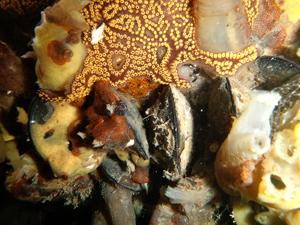Invasive Species in the Marine Environment
Marine ecosystems are damaged by many types of human impact, but most seriously by invasive (introduced, exotic, alien, non-indigenous) species brought in by human activities. This results mainly from commercial shipping, which opens up many new possibilities for transoceanic trips by founder individuals of invasive species. Some of the potential invasives are carried in ballast water, which is taken on for stability and carried across the ocean when a ship travels with a light cargo. The water, with a full complement of phyto- and zoo-plankton, is then discharged at the destination port when new cargo is loaded. Others species hitch-hike,
as "fouling organisms", on the outside of the ship's hull or on the sides of the ballast compartment. The fouling organisms include sessile animals such as sponges, mussels and tunicates, as well as more mobile animals that live among them. Most of the transported animals have pelagic larval stages, which can be released anywhere along the ship's journey to establish new exotic populations.
An additional source of non-indigenous species is the aquaculture industry, especially oyster farming which brings in exotic species with imports of oysters or oyster spat. The transport and sale of aquarium plants and fish, live bait, live seafood, and live organisms for use in research and teaching has also led to accidental release of exotic species into the marine environment.
San Francisco Bay has been widely reported as being the most invaded site on the Pacific coast, with over 175 exotic species established in the tidal area and 75 more in the Sacramento-San Joaquin Delta. Many of these species are so invasive and abundant that they dominate most of the Bay's ecosystems including mudflats, salt marshes, and brackish and fresh open water. In some of these habitats, exotic species account for over half to nearly all of the species, individuals, and biomass. The exotic species originated all over the globe, including Asia, South America, the Eastern U.S., the Atlantic Ocean and the Mediterranean, the Black Sea, and Australian and New Zealand waters. The rate of introductions has been increasing, from about one species per year between 1851 and 1960, to about four per year from 1961 to 1995.
Harbors and bays in Southern California may be as seriously affected by exotic species as San Francisco Bay, but are less well studied. They are known to be home to 106 exotic species including at least 14 non-indigenous species of ascidians (sea squirts or tunicates). Some of the ascidians arrived during the El Niño event of 1994-1997 and have persisted since then. Fairly recent exotic arrivals in west coast bays include several species of colonial tunicates, which form colorful geometric patterns on mussel shells as well as other substrates.
Aquatic Invasive Species
Caulerpa taxifolia or Killer Alga
Caluerpa is capable of rapid growth and reproduction of the invasive strain is asexual and dispersal occurs through fragmentation. Fragments as small as 1 cm give raise to viable plants. Long distance spread occurs...
Chytrid Fungus
Upwards of 40% of amphibian species are in decline worldwide, owing to several factors such as habitat loss, environmental degradation, pollutants, and disease. Recently the fungal pathogen Batrachochytrium dendrobatidis has emerged as a major threat to amphibians. Amphibians infected with B. dendrobatidis develop chytridiomycosis, which causes eventually death...
Didymo or Rock Snot
Upwards of 40% of amphibian species are in decline worldwide, owing to several factors such as habitat loss, environmental degradation, pollutants, and disease. Recently the fungal pathogen Batrachochytrium dendrobatidis has emerged as a major threat to amphibians. Amphibians infected with B. dendrobatidis develop chytridiomycosis, which causes eventually death...
Tunicates
Marine invasive species like these sea squirts are much more difficult to monitor and to control than their terrestrial counterparts. New detection methods promise to provide the early warning systems that are desperately needed in order to make progress...
Quagga and Zebra Mussels
As the common name indicates, this invasive pest is native to New Zealand. New Zealand mud snail has had a long invasion history. It was first found in the United Kingdom in 1859...
New Zealand Mud Snail
As the common name indicates, this invasive pest is native to New Zealand. New Zealand mud snail has had a long invasion history. It was first found in the United Kingdom in 1859 ...







